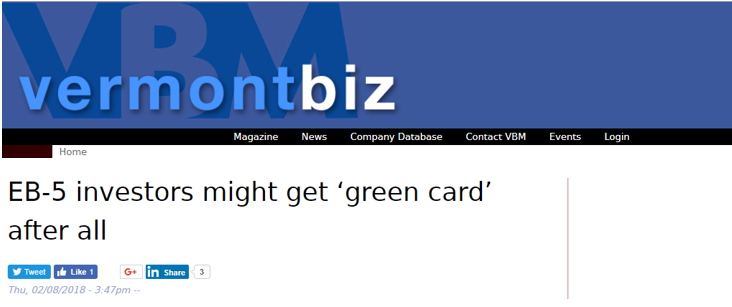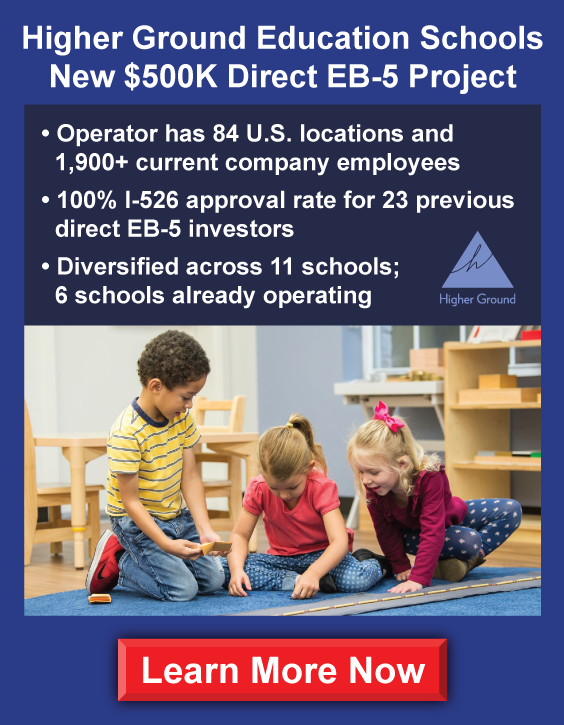A courtesy rendering of the never-built AnC Bio facility proposed for Newport. Investors in this EB-5 project now will get a chance to invest in a different project in New York City.
by Timothy McQuiston Vermont Business Magazine One of the earliest goals of Jay Peak receiver Michael Goldberg was to make the EB-5 immigrant investors who had been defrauded financially whole and, if possible, allow them the opportunity to complete the process of gaining a US “green card” for themselves and immediate family members. First, Goldberg and his team had to clean up the legal and financial mess resulting from the fraud that was revealed by state regulators and the US Securities & Exchange Commission in April 2016. He then had to get the resort businesses at Jay Peak and Burke Mountain back on firm footing.
Then, he had to actually get the $200 million back.
Last year Goldberg settled with investor Raymond James & Associates, Inc who had worked with the owner of the resorts and alleged benefactor of the fraud, Ariel Quiros. Raymond James’s Florida office was potentially on the hook for its role in backing Quiros financially. It settled with Goldberg for $150 million last April.

Receiver Michael Goldberg, left, with Governor Scott, announces the Raymond James settlement in April 2017 at the State House. VBM photos.
The final piece of the financial settlement was resolved February 6 when federal court Judge Darrin Gayles in Miami signed off on a settlement between the Securities & Exchange Commission and Quiros and former Jay Peak President Bill Stenger, which will return the “ill-gotten gain” to the receiver. Quiros will have to pay nearly $84 million, while Stenger, who was not seen as benefitting financially from the fraud, will pay only $75,000.
In the original complaint issued by the State of Vermont against Quiros and Stenger on April 12, 2016, the state alleged that they “misused more than $200 million by spending it on projects and acquisitions other than those for which it was invested.”
The funds Goldberg has gathered have and will allow the completion of all the projects the EB-5 foreign investors had invested in at $500,000 each, while allowing those who invested in projects that will never be built, specifically the AnC Bio facility in Newport, the option of either getting their money back or investing in a New York City EB-5 project.
Goldberg has said that his concern was always that while the investors could get their original money back, most if not all wanted the opportunity to get the permanent residence in the US the “green card” afforded.
Without a new project to invest in, the foreign investors would have to start the process from scratch, likely costing them several years.
EB-5 projects must be successful in meeting the terms of the law, which primarily involve reaching certain employment levels associated with the investment. If the project fails to do so, the investor would lose out. The investment also carries risk similar to any other investment. Therefore there is no guarantee that a “green card” will ever be issued or that they would ever get their money back, with or without interest.
However, because of the fraud involved in the AnC Bio part of the case, Goldberg wanted to give these investors a fair shot at gaining the “green card.”

Bill Stenger, right, makes opening remarks at the groundbreaking for the AnC Bio facility in Newport in May 2015, as Ariel Quiros listens. The plant was never built. VBM photos.
The federal court has established a Fair Fund for these investors to allow for the distribution of the civil penalties paid by Quiros and Stenger, along with the disgorgement and prejudgment interest paid by Quiros, to defrauded Jay Peak investors.
One of the ironies of this settlement is that US Senator Patrick Leahy (D-Vermont) has opposed EB-5 funds being used in places like Lower Manhattan, which, he has maintained, do not need this kind of capital that originally was earmarked for development in economically underserved regions of the country.
The project Goldberg has found is called One Wall Street, which is a redevelopment of an office building that sits directly next door to the New York Stock Exchange and which overlooks Trinity Church. Renovations on the former Mellon Bank building began in 2017.
Congress created the EB-5 Program in 1990 to stimulate the US economy through job creation and capital investment by foreign investors. In 1992, Congress created the Immigrant Investor Program, also known as the Regional Center Program. This sets aside EB-5 visas for participants who invest in commercial enterprises associated with regional centers approved by USCIS based on proposals for promoting economic growth.
USCIS administers the EB-5 Program. Under this program, entrepreneurs (and their spouses and unmarried children under 21) are eligible to apply for a green card (permanent residence) if they:
- Make the necessary investment in a commercial enterprise in the United States; and
- Plan to create or preserve 10 permanent full-time jobs for qualified U.S. workers.
This program is known as EB-5 for the name of the employment-based fifth preference visa that participants receive.
Applicants are required to invest $1 million, unless the project is in a “targeted employment area” (TEA), in which case they need only invest $500,000, a crucial difference for investors and a strategic difference for developers. The Jay Peak-related investments are in a TEA, as is the One Wall Street project.
Leahy, who was a staunch supporter of the EB-5 law when first introduced, is now a staunch supporter of requiring a thorough re-write of the law.
While he and the entire congressional delegation and then Governor Peter Shumlin openly praised the Jay Peak developments when first announced in September 2012, he has said in the last couple of years that it’s become clear that the EB-5 program is flawed, which has allowed for opportunities for abuse. He said the cases of fraud in Vermont and elsewhere and the “gerrymandering” of TEA districts to allow for wealthy areas to get funds undermine the law.
He’s said EB-5, if not re-written, should be scrapped.
In a Senate floor speech in September 2016, Leahy said: “The EB-5 program of today is mired in fraud and abuse. It has strayed from its important policy goals. The incentives that Congress created to direct investment to underserved areas—the very reason why I supported this program—have been rendered meaningless. The program has become an unintended boon for the wealthiest business districts in the country. Affluent areas now dominate the program by exploiting incentives intended for underserved areas, a practice Department of Homeland Security Secretary Johnson has rightly described as gerrymandering. It has gotten to a point where a luxury hotel in Beverly Hills qualifies as a distressed urban area. Only in the world of EB-5 is Beverly Hills considered economically distressed.”
And he probably could have mentioned One Wall Street also.
According to the publicity by developer Live In America : One Wall Street is “an iconic, 1.1 million-square-foot, landmarked office building being converted to a mixed-use project containing retail space and condominiums. The building was designated a New York City historical landmark and carries an internationally recognizable location and brand… The property’s Downtown Manhattan location continues to be one of the fastest growing areas in New York City… Macklowe Properties has a 50-year track record of real estate investment in New York City and most recently completed 432 Park Avenue, the tallest residential building in the western hemisphere… Renovation began in 2015 and is proceeding as planned. Whole Foods has been secured as an anchor tenant.”
Eventually, Receiver Goldberg will put the resorts up for sale as one unit. He has put off that date as all the other legal and financial machinations make their way through the process.
He previously told VBM he would put it up for sale in 2017, then in 2018, and a representative of Jay Peak told VBM in December 2017 that it would be another “two years,” or not before 2019, that the properties would be made available.
Mentions
States
- Vermont
Videos





Subscribe for News
Site Digest
Join Professionals on EB5Projects.com →
Securities Disclaimer
This website is for informational purposes only and does not constitute an offer or solicitation to sell shares or securities. Any such offer or solicitation will be made only by means of an investment's confidential Offering Memorandum and in accordance with the terms of all applicable securities and other laws. This website does not constitute or form part of, and should not be construed as, any offer for sale or subscription of, or any invitation to offer to buy or subscribe for, any securities, nor should it or any part of it form the basis of, or be relied on in any connection with, any contract or commitment whatsoever. EB5Projects.com LLC and its affiliates expressly disclaim any and all responsibility for any direct or consequential loss or damage of any kind whatsoever arising directly or indirectly from: (i) reliance on any information contained in the website, (ii) any error, omission or inaccuracy in any such information or (iii) any action resulting therefrom.



